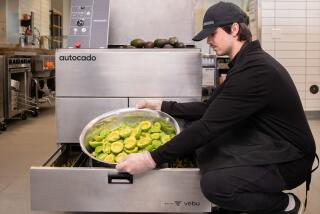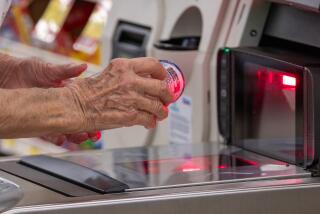Check This Out: A Revolution in the Supermarket : Shoppers turn into their own grocery clerks as automated checkout machines shorten those long lines of carts and reduce markets’ personnel costs
CHICAGO — The nation’s grocers are being offered the ultimate labor-saving device: a checkout system in which shoppers tally their own grocery bills in the complete absence of store personnel.
This “revolution” in supermarket productivity, called the Automatic Checkout Machine, is a sleek, audio-visual relative of the computer-like money dispensers at banks throughout the country.
What is being called “a giant leap forward” in grocery technology was unveiled here earlier this week by CheckRobot Inc. at the annual convention of the Food Marketing Institute, a retailers’ trade association.
The Deerfield Beach, Fla.,-based firm’s system attracted a great deal of attention from the 27,000 in attendance. Many marveled, for instance, at a demonstration of the checkout machines given by an 11-year-old, ostensibly to underline the ease with which the average consumer can become the self-sufficient grocery clerk of the future.
Response to the futuristic checkout at the convention has been “outstanding,” according to David R. Humble, president of CheckRobot Inc. “This is a revolutionary product that will start in the supermarket and go into other areas such as department stores and discount drug stores--it will sweep all of retail.”
Humble said there was little resistance to the machine in a recent test market situation. Few people, in fact, worried that automatic checkout would eliminate the human touch from a business that has always promoted itself as a friendly neighborhood institution.
“(This is) the next generation of scanner where the customer is able to check out their own groceries and, for the first time in history, shop in a totally self-service store,” said Donald F. Dufek, vice president for the Kroger Co., a Cincinnati-based supermarket chain that has been testing the CheckRobot system in one of its Atlanta-area stores since August.
The shopper-operated system employs the same laser scanner, or light beams, now used by most checkouts to read the bar codes or series of lines and numbers found on packaging. However, the similarities with current cash registers end there.
With Automatic Checkout Machines, the consumer is led through the scanning process by a touch-sensitive, color TV monitor. Once activated through the pressing of the screen’s start button, an unnamed blond woman appears on video to offer instructions and assistance in an assuring tone. Each time an item is passed over the laser scanner, another computer voice reads off the price.
The scanning device and a TV monitor are located at the checkout line’s entry rather than at the end, as is now the case. After the shopper scans a food product, the item is carried down a conveyor belt to a clerk who bags the groceries. Another scanner farther along the belt ensures against any fraudulent manipulation of the system. For instance, any errors or missed scans cause the conveyor to reverse and send the questioned item back to the shopper to be reprocessed.
Finally, a cashier, located just beyond the conveyors, accepts payment. Only one such cashier is needed per three of the CheckRobot aisles, which, incidentally, fit into the space occupied by only two of the standard checkout systems.
“After just 14 weeks, two-thirds of the customers (in the Atlanta Kroger store) had used the self-service system,” said Dufek, who was pleased with the percentage because only three of the store’s eight checkouts were automatic. “Also encouraging was the number--38%--who said they preferred self-service checkout.”
Dufek said that the system was preferred because most said it was faster, more accurate and fun. Another positive development was that 81% of those who used the system experienced no operational problems. Proponents of the machines say that if they prove successful, and consumer testing seems to indicate that they are popular, then a fully automated grocery store may not be too far behind.
“Envision this: A consumer enters the store, purchases some milk, bread and eggs, approaches the (cashier machine), swipes an (ATM) debit or credit card, scans the groceries, scans any coupons, totals the bill, takes the receipt and groceries from the bagger and leaves the store,” said Dufek in a speech to the convention.
Kroger’s initial interest in the system was to speed checkout, generally considered a major problem area for the grocery industry because of consumer dissatisfaction with long, tedious lines.
As important is the potential labor savings that could be realized by markets if the number of checkers could be reduced by the machines’ installation.
The system also addresses a growing labor shortage that has been troubling retailers. In fact, an FMI survey released during the convention found that 51% of all those grocers queried reported difficulties recruiting employees, citing low wages as the reason fewer young people are interested in cashier or clerk jobs.
Kroger officials were pleased enough with CheckRobot that they opened a store with a fully automated checkout system March 1 in Decatur, Ga.
Humble of CheckRobot said it was too soon to draw any conclusions about the Decatur store’s performance. Nevertheless, he said the trends during the first eight weeks are the same, namely consumer acceptance for self-checkout.
Despite the excitement generated by the machines, several problems still exist. Not all products in a supermarket today carry the pricing codes. In particular, a new system would have to be developed to code fresh fruit and vegetables. A European-designed machine now being tested weighs and instantaneously prints a price tag for each item of fresh produce selected by a shopper, but other options are also under review.
There is also the prospect that unions representing retail clerks would be unenthusiastic about the installation of machines that would render most of their jobs superfluous.
More to Read
Inside the business of entertainment
The Wide Shot brings you news, analysis and insights on everything from streaming wars to production — and what it all means for the future.
You may occasionally receive promotional content from the Los Angeles Times.










